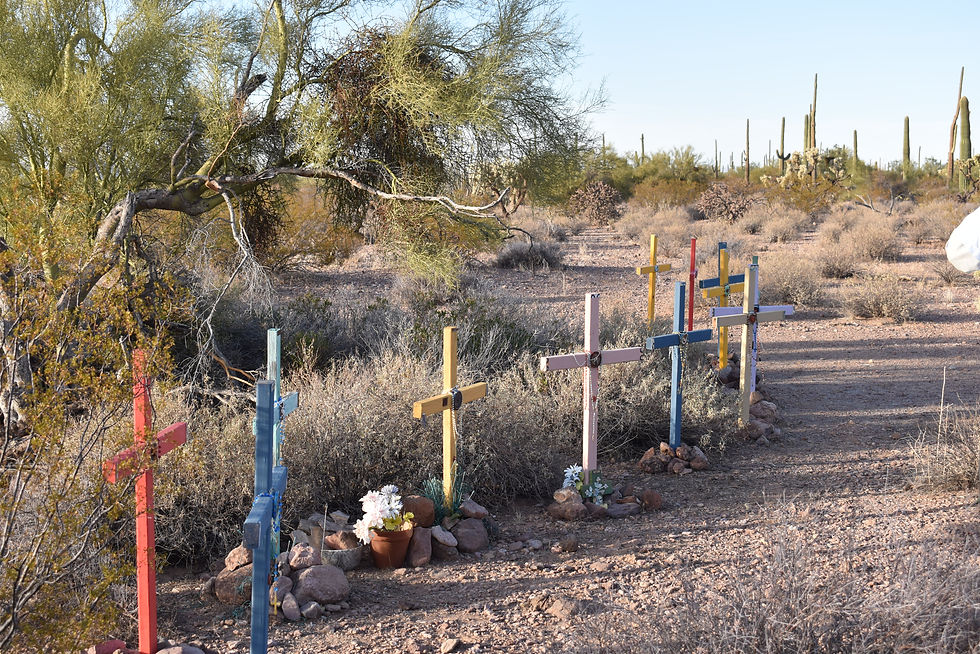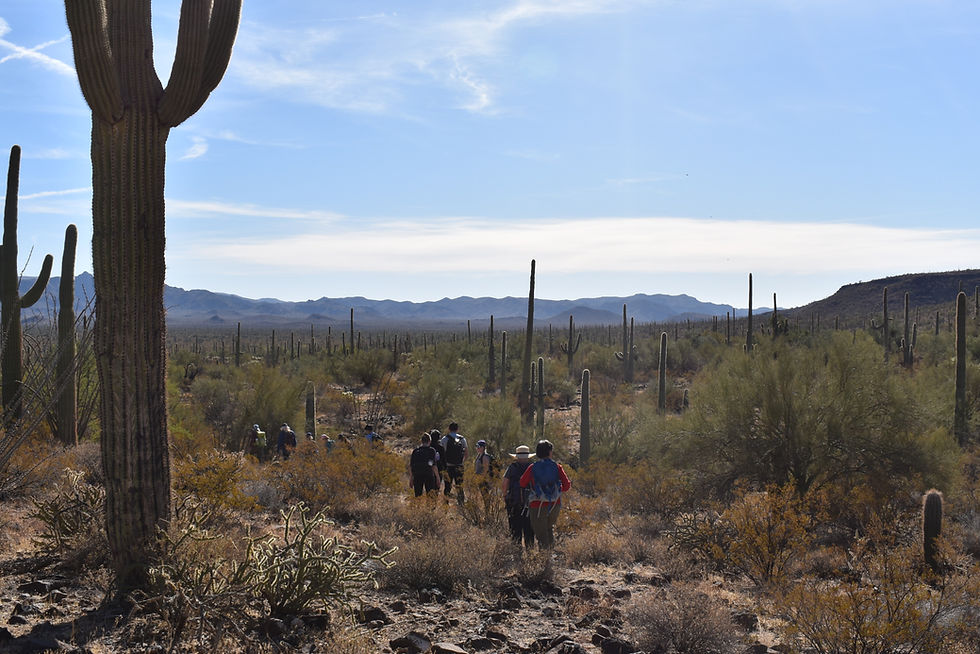At the border in the Tohono O’odham Nation
- Benedictine Sisters of Chicago
- Jan 9
- 4 min read
Updated: Jan 10
by Sr. Belinda Monahan
The border between Mexico and the United States runs right through the Tohono O’odham Nation, situated just west of Tucson, Arizona. As a sovereign nation, they insisted on a border wall that allows wildlife through, yet keeps cars out. It is much less imposing than the wall that marks the border to the east and west of the nation. Anyone with a tribal identification card can cross the border at the San Miguel Gate, after contacting Border Patrol, and it is here where the stories of the Tohono O’dham Nation and immigrants crossing from Mexico merged into one.
Left: The border wall on the Tohono O’odham Nation allows wildlife to cross but keeps the cars out.
Center: With a tribal ID, the Tohono O’odham are able to cross the border here at San Miguel Gate, but they must contact Border Patrol first.
Right: Sign at the gate provides Border Patrol information in English, Spanish, and Oʼodham.
The San Solano Mission on the Tohono O’dham Nation lands was my home base for a week in December, during which I had the privilege to travel to Arizona with nine Northwestern students and fellow campus minister Tim Higgins, to learn about the Tohono O’odham people and the situation at the border.
Many of the people we met asked us to make sure that we shared their stories, so while I cannot possibly recount all of what we saw and experienced, this is my attempt to share what was a graced encounter with migrants, the Tohono people, and those who work tirelessly to serve both of these groups.
The Tohono we met described themselves as a people with a foot in both worlds: The modern world – in which they use the internet and are voting citizens of the United States, and the traditional world of the Tohono – in which the customs and traditions of the past are rapidly being forgotten though remain important to the people. I found their stories and music fascinating and moving, and – while slipping into “anthropologist mode” – I was intrigued by the fact that the stories we heard could only be told in winter, and were tied to the land, rather than belonging to the people who occupy the land. I wanted to ask endless more questions about what their daily life is like.
Due to shifting U.S. policies and various constraints on our group, we directly met with very few recent immigrants, so opportunities to hear their stories were very limited. However, we did meet Dora, who in 1980 fled for her life during El Salvador’s Civil War and crossed the border into Arizona without documents. Half of the 26 people with whom she traveled died in the desert. She was rescued by Border Patrol, and our group accompanied her to the location where she was found. Dora fought to remain in the United States and founded the nonprofit Salvavision, which provides aid and support to asylum seekers and those who have been deported.

The circumstances in which migrants find themselves are often degrading, designed to make them feel and appear less than human. On this trip, I noticed in a special way the men and women who strive to uplift migrants’ humanity. One example is the volunteers of the Ajo Samaritans who accompanied us on our water drop, drove us out into the desert, or loaned us the trucks so that we could do both. Many are retired from jobs in business and have chosen to spend their retirement in this way.

On our trip to Centro de Esperanza – a shelter in Sonoyta, Mexico for migrants awaiting their appointment to travel to the US – founder John observed that this work was selfish on his part, since he received so much joy from doing it. He initially refused to let migrants housed in his shelter work, as he did not want their presence to be in anyway transactional.
In a final story about finding humanity, we spent one morning in a courtroom as close to fifty men and women arrested for being in the United States without documentation were processed through federal court. Most of young men and women appeared to be the same age as the students we accompanied, and their presence in prison jumpsuits and shackles was startling. All had agreed to plead guilty to a misdemeanor charge in exchange for dropping a felony charge and substantial fine. The defense attorneys each defended about ten men and women, as the judge asked the same questions of each of them. Although everyone was professional, one of the attorneys stood out for humanizing her clients, standing behind each of them with her hand on their shoulder.
While many parts of this trip were difficult, I felt privileged to be with the Tohono O’dham Nation and to bear witness to the journeys of migrants at the border. I pray that we can each find ways to humanize the most vulnerable in our communities and be the supportive hand on their shoulder.












